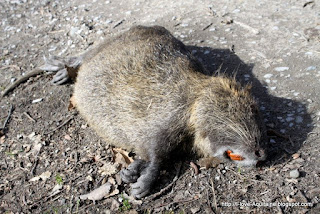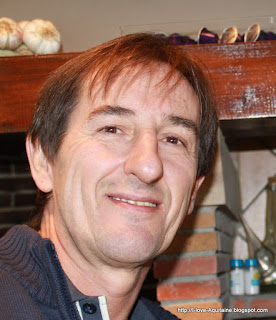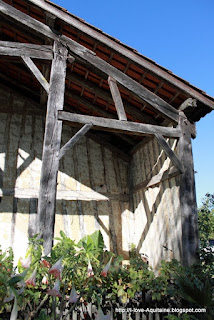My cousin
Just to lay flat on the surf board and paddle through the waves to get out to the right spot has left me panting for air. But Christophe doesn't give me much time to recover. He turns the board to face the shore and quickly gives me some instructions. When I tell you, start paddling as fast as you can and then stand up on the board when I tell you!
Erretegia beach
This happened last summer. I am so incredibly happy that I finally did try to surf! Can't live so close to these waves without at least trying, can you? But the truth is that I haven't tried earlier because I was afraid. The Atlantic waves are huge. Impressive. Beautiful. Scary. I had visions of a surf board that would hit the back of my head and send me unconscious turning in the bubbly water... But here they have soft beginners boards. And, as Johanna says,
everybody can surf.
We start at the Erretegia beach in Bidart. I’m here with some friends and family. The sea is shimmering, the sky is high and blue and the air is warm. A perfect summer day. We start by trying on the wet suits and let them hang from the waist until we jump into the water. I and another girl carry two boards between us. When my feet touch the sand, I feel this warm feeling of intense happiness as I gaze out over the sea.

The waves are pretty small, about a meter. Perfect for beginners, says Christophe. We start with some theory that of course focuses on all the dangerous things that can happen. The force of a big wave behind a board can crush both a nose and whack out teeth. I feel butterflies start flying around in my stomach. We check to see if we are left footed or right footed, to decide which foot you put in front of you on the board, and learn how to attach the safety rope. Our instructor shows us how to lie on the board when you paddle out to stay in balance. He also shows how to stand up. Preferably in one swift jump. Ha! Try yourself to lie flat on you stomach with your palms facing the ground and try to jump up to standing in one move! I listen more carefully when he tells us about the other option, which is to stand up in steps. Place your hands first, then one foot after the other and then you let go of your hands.

Now it is time to hit the waves. The butterflies are getting crazy in there, but they disappear the moment I get into the water. I don't have time to worry about them! I am too busy just to stay on the board, paddle with my arms and try to get past those waves. Again that intense feeling of happiness comes, with the sun in my eyes and the salty water splashing over my head. Silly, but I'm happy just lying here on my board!
I keep fighting to get past those waves. It is incredibly tiring and I am quickly out of breath, so hard I am working with my arms. When I finally reach the right spot, Christophe sends me off at once. The wave is rising up behind me and I paddle like crazy. Stand up! I feel how the board is supported by the wave. The water is hissing at the sides of the board. I put my hands in front of my on the board, like I have been told, put up a foot and then another, feel the force of the water under my board and then I let go of my hands. I'm standing up! It doesn't last for long, but what a kick!
With a huge smile I get back on my board and start paddling again. I want that feeling again! I keep on trying, but now I can't get to stand on the right spot to be in balance and fall before I manage to stand up. But now I'm not tired anymore. I keep trying and trying. Until I paddle out and realize that I'm the only one left in the water. I get out of the water, but one thing is for sure, this was not the last time!
Surf school in Bidart. Here my friend Johanna works with her husband Christophe.























































